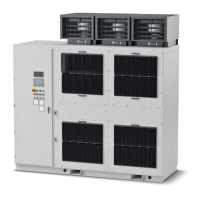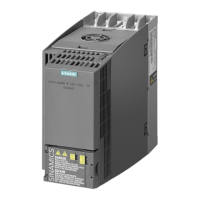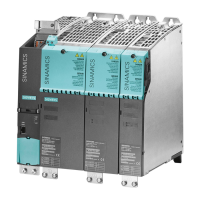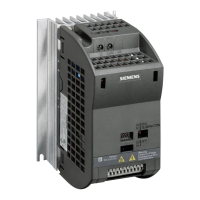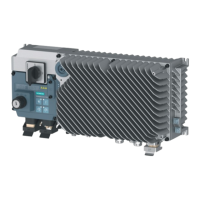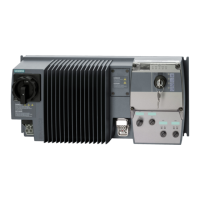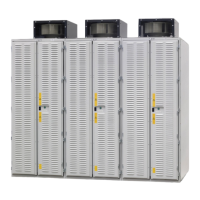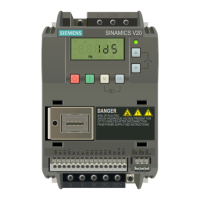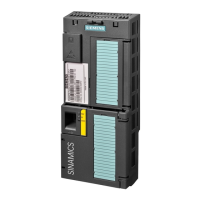Do you have a question about the Siemens SINAMICS PM240-2 and is the answer not in the manual?
Provides essential safety instructions for handling electrical devices and preventing hazards.
Information on industrial security concepts and protection against cyber threats.
Specifies general conditions for reliable and disturbance-free operation.
Guides on proper installation to ensure electromagnetic compatibility.
Details on assigning devices to zones and electromagnetically uncoupling them.
Instructions for routing power and signal cables within and outside the cabinet.
Explains cooling requirements based on power loss and airflow calculation.
Specifies rules for admissible mounting, clearances, and protection.
Step-by-step procedure for installing Power Modules based on frame sizes.
Provides dimensional data and drilling patterns for IP20 devices.
Details dimensions and drilling patterns for PT Power Modules.
Warns about shock hazards due to improper touch protection.
Outlines permissible line supplies (TN, TT, IT systems) according to IEC standards.
Details operation on TN systems with integrated or external line filters.
Specifies operation on TT line systems with or without integrated line filters.
Explains operation on IT line systems, including requirements for output reactors.
Details requirements for protective conductor cross-section and integrity.
Provides an overview of connecting line and motor cables.
Specifies permissible motor cable lengths based on EMC category and pulse frequency.
Details connection types, cross-sections, and torques for PM240-2 modules.
Provides procedures for establishing connections, including removing covers.
Explains implementing the "Safe Torque Off" function via terminals.
Describes connecting motors in star or delta configuration.
Warns about hazards from defective components and overcurrent protection.
Specifies who is authorized for repairs and the use of original spare parts.
Outlines regular maintenance tasks like cleaning, ventilation, and checking terminals.
Defines "Low Overload" and "High Overload" load cycles.
Explains EMC, environments, and categories for variable-speed drives.
Information on braking resistors, including mounting and warnings.
Details how to connect braking resistors and monitor their temperature.
Provides essential safety instructions for handling electrical devices and preventing hazards.
Information on industrial security concepts and protection against cyber threats.
Specifies general conditions for reliable and disturbance-free operation.
Guides on proper installation to ensure electromagnetic compatibility.
Details on assigning devices to zones and electromagnetically uncoupling them.
Instructions for routing power and signal cables within and outside the cabinet.
Explains cooling requirements based on power loss and airflow calculation.
Specifies rules for admissible mounting, clearances, and protection.
Step-by-step procedure for installing Power Modules based on frame sizes.
Provides dimensional data and drilling patterns for IP20 devices.
Details dimensions and drilling patterns for PT Power Modules.
Warns about shock hazards due to improper touch protection.
Outlines permissible line supplies (TN, TT, IT systems) according to IEC standards.
Details operation on TN systems with integrated or external line filters.
Specifies operation on TT line systems with or without integrated line filters.
Explains operation on IT line systems, including requirements for output reactors.
Details requirements for protective conductor cross-section and integrity.
Provides an overview of connecting line and motor cables.
Specifies permissible motor cable lengths based on EMC category and pulse frequency.
Details connection types, cross-sections, and torques for PM240-2 modules.
Provides procedures for establishing connections, including removing covers.
Explains implementing the "Safe Torque Off" function via terminals.
Describes connecting motors in star or delta configuration.
Warns about hazards from defective components and overcurrent protection.
Specifies who is authorized for repairs and the use of original spare parts.
Outlines regular maintenance tasks like cleaning, ventilation, and checking terminals.
Defines "Low Overload" and "High Overload" load cycles.
Explains EMC, environments, and categories for variable-speed drives.
Information on braking resistors, including mounting and warnings.
Details how to connect braking resistors and monitor their temperature.
| Product type designation | SINAMICS PM240-2 |
|---|---|
| Protection class | IP20 |
| Input | 3-phase |
| Voltage | 380-480V AC |
| Frequency | 47-63Hz |
| Output | 3-phase |
| Communication interfaces | PROFIBUS, PROFINET, USS, Modbus RTU |
| Braking chopper | Integrated |
| Relative humidity | 5 ... 95% (non-condensing) |
| Cooling method | Internal air cooling / External air cooling (depending on frame size) |
| Storage temperature | -25 ... +70 °C |

